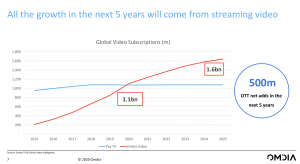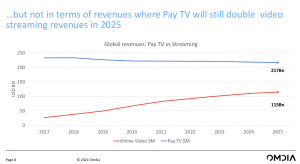
After more than 35 years of operation, TBI is closing its doors and our website will no longer be updated daily. Thank you for all of your support.
TBI Tech & Analysis: Plotting the next moves for pay TV & SVOD
SVOD services boomed in 2020 as locked down viewers turned to on-demand viewing for entertainment, yet despite the proliferation of streamers, pay TV is set to remain the major revenue source in the coming years, writes Stuart Thomson.
All growth in pay video in the next five years will come from streaming services but pay TV will still dominate revenue, with half of all net additions coming from APAC.
That finding comes from research revealed recently by Maria Rua Aguete, Omdia’s senior research director, media and entertainment. While growth rates will slow down after the bumper year of 2020, global online video subscriptions will grow to 1.6 billion by 2025, up from 1.1 billion today, while pay TV numbers will more or less flatline at just over one billion.
However, pay TV will continue to deliver more revenue overall – $217bn in 2025 compared with $115bn for online video. In most global markets, pay TV revenues remain higher than SVOD and AVOD revenues together.
Half of total OTT net additions will come from the APAC region over the next five years, with North America accounting for 26% and western Europe for 12%, according to the Omdia data.
Global outlook
While 2020 and early 2021 might have been all about the launch of DTC streamers from the US studios, research suggests that it will be the Queen’s Gambit streamer Netflix that continues to hold global dominance come 2025.
Stellar growth from Disney+, together with sister services Hulu and ESPN+, will see the Mouse House-owned SVOD’s become the leading group of streaming services in the US, but it won’t be sufficient to knock the incumbent from its top spot across the global industry as a whole.
Disney+ and Amazon Prime Video will also continue to dominate the market globally alongside Netflix, together accounting for over a third of total SVOD subscriptions between them.
Netflix leads at present with around 203 million subscribers, compared with 100 million for Disney+ and 96 million for Amazon Prime Video.
Broad appeal
The surging SVOD growth experienced in 2020 is unlikely to be repeated, but Omdia’s research did find that consumers’ appetite for all types of video service is expanding, with US customers using an average of 8.71 services.
This compares with 6.5 services in the UK and 4.91 in Germany, while Japan is something of an outlier among advanced markets, with consumers using an average of only 3.01 services.
Omdia also predicts that operator-OTT partnerships will accelerate this year, with a range of packaging and pricing models helping to mitigate the cost of OTT services to subscribers. OTT channel aggregation on the model of Amazon Channels is also growing, with revenues for the top three aggregators – Amazon, Apple and Roku – expected to pass $4 billion by 2024.





